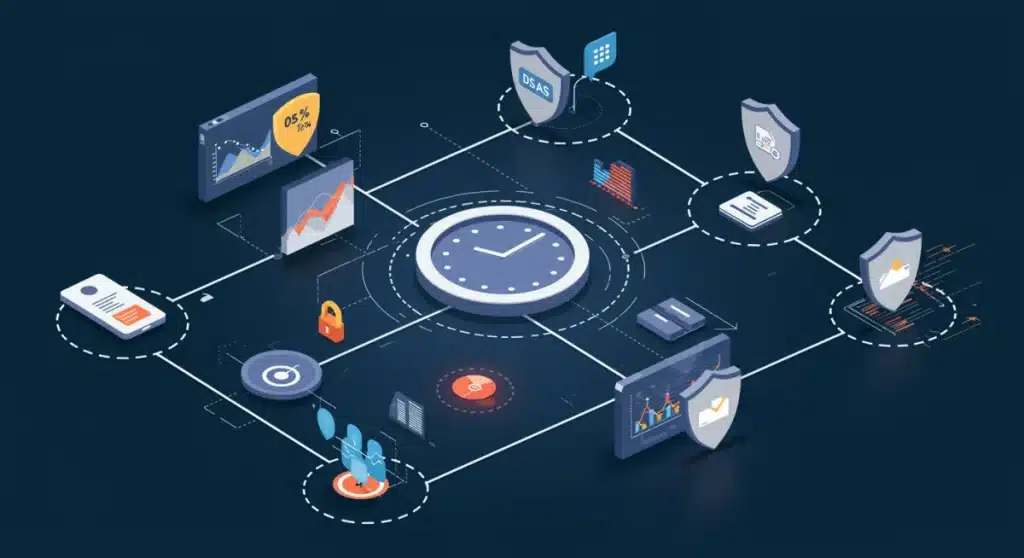Cookie-less Future: 4 Strategies US Marketers Must Implement by Q2 2025

The imminent cookie-less future by Q2 2025 demands US marketers adopt four critical strategies: prioritize first-party data, leverage privacy-enhancing technologies, embrace contextual advertising, and develop robust measurement frameworks to ensure continued campaign efficacy.
The digital advertising landscape is on the cusp of a monumental shift. The deadline for the cookie-less future: 4 strategies US marketers must implement by Q2 2025 is fast approaching, marking a critical juncture for businesses relying on third-party cookies for targeting and measurement. This transition, driven by increasing privacy regulations and browser changes, necessitates urgent strategic adaptation from all US marketers.
Understanding the Imminent Cookie-less Transition
The impending deprecation of third-party cookies by major browsers, notably Google Chrome, by Q2 2025, is set to fundamentally reshape digital advertising. This move, primarily driven by consumer demand for greater privacy and evolving regulatory frameworks like GDPR and CCPA, challenges traditional targeting, personalization, and measurement methodologies. Marketers must grasp the full scope of this change to navigate it successfully.
As of late 2023, Google has already begun testing its Privacy Sandbox initiatives, gradually phasing out third-party cookies for a small percentage of users. This phased approach underscores the company’s commitment to the timeline, pushing marketers to accelerate their preparations. The impact extends beyond mere technical adjustments; it requires a complete re-evaluation of how consumer data is collected, utilized, and respected.
The Shift in Data Collection
The core of the cookie-less future lies in a paradigm shift from reliance on easily accessible third-party data to a greater emphasis on direct consumer relationships. This means:
- First-Party Data Dominance: Data collected directly from customer interactions with a brand’s website, apps, and services becomes paramount.
- Consent-Based Approaches: Explicit user consent for data collection and usage will become the standard, requiring transparent communication.
- Data Clean Rooms: Secure environments for collaborating on anonymized data without sharing underlying raw data are gaining traction.
Strategy 1: Prioritizing First-Party Data Collection and Activation
With third-party cookies fading, the immediate and most impactful strategy for US marketers is to aggressively build and leverage their first-party data assets. This involves direct relationships with customers, collecting data they willingly share, and using it responsibly to enhance their experience. This foundation is crucial for maintaining personalized marketing efforts in the absence of traditional tracking.
Implementing robust first-party data strategies requires an integrated approach across all customer touchpoints. This includes optimizing website analytics, consolidating customer relationship management (CRM) systems, and developing engaging content that encourages users to share information. The quality and breadth of this data will directly correlate with future marketing effectiveness.
Enhancing First-Party Data Acquisition
To truly prioritize first-party data, marketers should focus on several key areas:
- Loyalty Programs: Incentivize sign-ups and data sharing through exclusive offers and personalized experiences.
- Content Gating: Offer valuable content in exchange for email addresses or other relevant information.
- Interactive Experiences: Quizzes, surveys, and polls can provide valuable insights directly from users.
Beyond collection, the activation of this data is equally vital. Marketers need to invest in Customer Data Platforms (CDPs) to unify, segment, and activate first-party data across various marketing channels. This enables a holistic view of the customer journey, facilitating more targeted and relevant communications without relying on third-party identifiers. The goal is to create a seamless and personalized experience that fosters loyalty and drives conversions.
Strategy 2: Embracing Privacy-Enhancing Technologies (PETs)
The cookie-less future mandates a deep dive into privacy-enhancing technologies (PETs). These innovative solutions allow marketers to gather insights and deliver personalized experiences while rigorously protecting user privacy. PETs are not merely compliance tools; they represent a forward-thinking approach to data utilization that builds trust with consumers.
PETs encompass a range of techniques designed to minimize data exposure and enhance anonymity. This includes differential privacy, homomorphic encryption, and federated learning, all of which aim to extract value from data without compromising individual identities. US marketers must begin experimenting with these technologies now to understand their capabilities and limitations before the Q2 2025 deadline.
Key PETs for Marketers
- Differential Privacy: Adds statistical noise to data sets, making it difficult to identify individuals while still allowing for aggregate analysis.
- Homomorphic Encryption: Allows data to be processed while encrypted, ensuring privacy even during computation.
- Federated Learning: Trains AI models on decentralized data sets, meaning data remains on individual devices rather than being centralized.
The adoption of PETs also extends to secure data clean rooms, which provide a neutral, privacy-safe environment for multiple parties to collaborate on first-party data. This allows brands to match and analyze customer data with partners without exposing personally identifiable information, offering a viable path for audience segmentation and campaign measurement in a privacy-centric world. Investing in PETs is an investment in future-proof marketing.

Strategy 3: Re-evaluating and Investing in Contextual Advertising
As personalized targeting via third-party cookies diminishes, contextual advertising is experiencing a powerful resurgence. This strategy places ads on web pages or apps based on the content of the page itself, rather than the user’s browsing history. It’s a privacy-friendly approach that aligns advertising messages with user interests in the moment, proving highly effective.
Contextual advertising leverages advanced AI and machine learning to analyze content for keywords, sentiment, and topics, ensuring ad placement is highly relevant. This method respects user privacy by not relying on individual tracking, offering a sustainable alternative for reaching target audiences. Marketers should actively explore and invest in platforms that offer sophisticated contextual targeting capabilities.
Advantages of Contextual Advertising
- Privacy-Compliant: No reliance on personal data or tracking, aligning with new privacy regulations.
- High Relevancy: Ads appear alongside relevant content, increasing engagement and recall.
- Brand Safety: Advanced tools help ensure ads are placed in appropriate and brand-safe environments.
The shift towards contextual advertising also encourages marketers to think more deeply about their content strategy and how it aligns with potential ad placements. Understanding where target audiences consume information and what topics resonate with them becomes paramount. This approach fosters a more thoughtful and integrated advertising ecosystem, moving away from intrusive tracking towards value-driven content alignment. It’s a vital component for the cookie-less future: 4 strategies US marketers must implement by Q2 2025.
Strategy 4: Developing Robust Measurement and Attribution Frameworks
The absence of third-party cookies poses a significant challenge to traditional campaign measurement and attribution models. Marketers must proactively develop new frameworks that can accurately assess campaign performance without relying on individual-level tracking. This requires a shift towards aggregated data, advanced analytics, and diversified measurement techniques.
New measurement approaches will involve a combination of techniques, including first-party data analysis, incrementality testing, mixed-media modeling (MMM), and clean room solutions. The goal is to move beyond last-click attribution and gain a more holistic understanding of how various touchpoints contribute to conversions, all while respecting user privacy. This evolution is non-negotiable for proving ROI in the cookie-less era.
Key Measurement Adaptations
- First-Party Data Integration: Use internal customer data to track user journeys and conversion paths.
- Incrementality Testing: Measure the true impact of campaigns by comparing exposed groups to control groups.
- Mixed-Media Modeling (MMM): Statistical analysis to quantify the impact of different marketing channels on sales or conversions.
Furthermore, marketers should explore privacy-centric measurement solutions offered by platforms like Google’s Privacy Sandbox, which aim to provide aggregate reporting without individual tracking. Adapting measurement strategies is not just about finding alternatives; it’s about building a more resilient and ethical approach to understanding marketing effectiveness. This proactive development is critical for US marketers to remain competitive and accountable by Q2 2025.
The Role of AI and Machine Learning in the Cookie-less Era
Artificial Intelligence (AI) and Machine Learning (ML) are set to play an indispensable role in navigating the cookie-less future. These technologies can process vast amounts of first-party and contextual data to identify patterns, predict consumer behavior, and optimize campaigns without relying on individual identifiers. AI-driven insights will become the new currency for effective targeting and personalization.
From predictive analytics that anticipate customer needs to advanced segmentation based on behavioral clusters rather than individual profiles, AI and ML offer scalable solutions. They can help marketers make sense of anonymized data sets, enhance contextual targeting precision, and even assist in the development of more sophisticated attribution models. The investment in AI capabilities is no longer optional but a strategic imperative.
AI Applications for Marketers
- Predictive Analytics: Forecasting customer churn, lifetime value, and purchase intent based on first-party data.
- Automated Content Personalization: Delivering dynamic content experiences tailored to user segments identified by AI.
- Optimized Contextual Targeting: AI algorithms can analyze content in real-time to ensure the most relevant ad placement.
Moreover, AI can significantly enhance the efficiency of data clean rooms and the implementation of Privacy-Enhancing Technologies, ensuring that data collaboration and analysis adhere to the highest privacy standards. By leveraging AI, US marketers can transform the challenge of the cookie-less future into an opportunity for more intelligent, ethical, and effective marketing. This technological embrace is a cornerstone of the cookie-less future: 4 strategies US marketers must implement by Q2 2025.
| Key Strategy | Brief Description |
|---|---|
| First-Party Data | Focus on direct customer data collection and activation through CRMs and CDPs. |
| Privacy-Enhancing Technologies (PETs) | Implement solutions like differential privacy and data clean rooms for secure insights. |
| Contextual Advertising | Place ads based on content relevancy, not user tracking, using AI and ML. |
| Robust Measurement | Develop new attribution models like MMM and incrementality testing for accurate ROI. |
Frequently Asked Questions About the Cookie-less Future
Google Chrome aims to fully phase out third-party cookies by Q2 2025. Other browsers like Safari and Firefox have already implemented similar restrictions, making this a universal industry shift for US marketers.
First-party data is information collected directly from your customers, like website interactions or purchase history. It’s crucial because it’s privacy-compliant and offers direct insights into your audience without third-party tracking.
Contextual advertising will become more sophisticated, using AI to analyze page content and sentiment for highly relevant ad placements. It ensures ads align with user interest in the moment, without tracking individual browsing history.
PETs are tools and techniques, such as differential privacy and data clean rooms, that allow marketers to extract insights and collaborate on data while minimizing individual identification and protecting user privacy.
New measurement frameworks will rely on first-party data analysis, incrementality testing, and mixed-media modeling (MMM). These methods provide aggregated insights into campaign effectiveness without individual-level tracking.
What Happens Next
The transition to a cookie-less digital advertising ecosystem is actively unfolding, with Q2 2025 serving as a critical benchmark. US marketers who delay adapting risk significant disruption to their campaign effectiveness and ROI. The coming months will see accelerated adoption of privacy-centric solutions and increased investment in first-party data infrastructure. Industry stakeholders anticipate further clarity and refinement of Google’s Privacy Sandbox initiatives. Watch for new partnerships and technological innovations emerging in the measurement and contextual advertising spaces, as the industry collectively works to define the next generation of digital marketing. Proactive engagement with these changes is paramount for sustained success.





